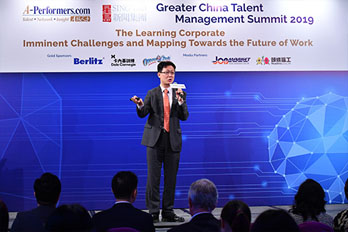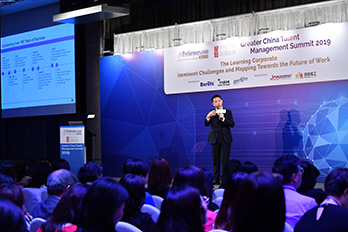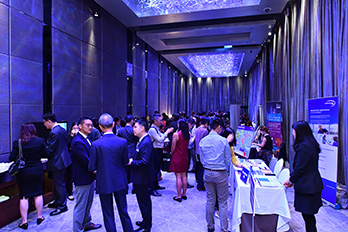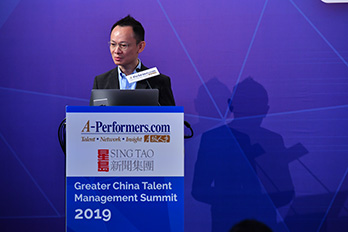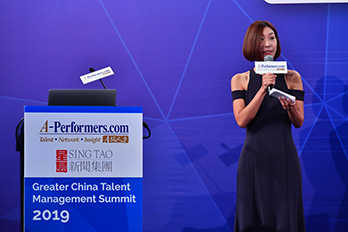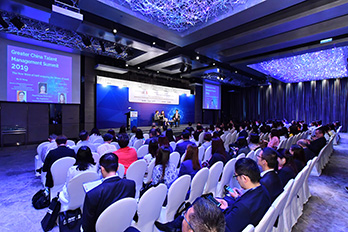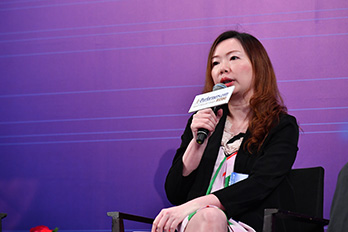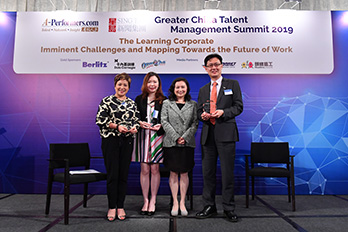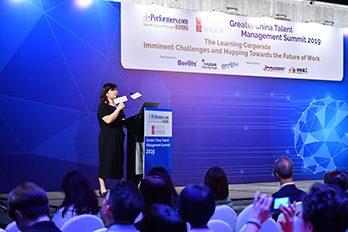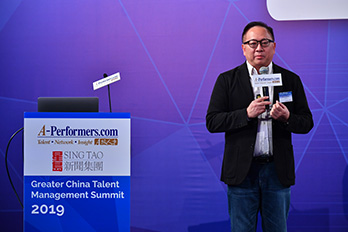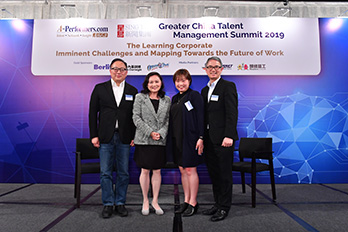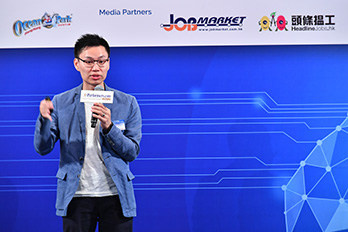The Greater China Talent Management Summit 2019
The Learning Corporation – Imminent Challenges and Mapping Towards the Future of Work
In today’s ever-changing business environment, building a learning culture has become an essential aim for many organisations in order to become better equipped against market competition and evolution. Moreover, learning and development play a critical role in engaging and retaining employees. It is also vital to facilitate a meaningful digital transformation within a corporation. This holds true especially for millennial employees who are motivated more by opportunities to develop their skills and knowledge base than by other incentives such as competitive remunerations, an informal work environment, or other benefits. Most young people today want to work for employers who can provide personal and professional development, and they consider this a key deciding factor when looking for new job or determining whether or not they should stay with their current firms.
The Greater China Talent Management Summit 2019, organised annually in late June by A-Performers.com, has been highly regarded by senior human resources professionals across the greater China region for more than a decade as a valuable platform for sharing insights as well as best practices, and it is also considered a highly worthwhile event for talent management.
Under the theme of – ‘The Learning Corporate – Imminent Challenges and Mapping Towards the Future of Work', the organiser invited nine top-tier HR and management experts across different business sectors to share and discuss how they and others are using different approaches to create effective learning strategies.
Invest in People, Processes and Technology in Equal Parts
The first speaker at the conference, C.F. Wong, North Asia advisory committee member of the AICPA (American Institute of CPAs) – CIMA (Chartered Institute of Management Accountants), predicts that many current professionals such as accountants and tax preparers will be replaced by new technologies like artificial intelligence (AI), robotic progress automation (RPA), and blockchain, etc. Despite these threatening trends, there will be many new jobs created that make use of human judgement and programming, like big data and AI scientists, psychologists and therapists, entertainment professionals, private services for the rich, as well as those practitioners at the top 10% of their industries who are necessary to make sure things go well. “Leadership, empathy, story-telling, communication, creativity and imagination are our human strengths,” says Wong. “Organisations should invest in people, processes and technology in equal parts while also encouraging and supporting staff to ‘up-skill’ themselves in the name of innovation and automation.”
Outline Five Key Components of Continuous Training Journey
Many corporations encounter challenges created by a multi-generational workforce in the same office, comprising baby boomers, Gen Xers, and millennials all the way to the latest Gen Z employees. Andrew Yeung, training manager and corporate trainer for Dale Carnegie Training, stresses that it is important to develop learning strategies that can engage everyone across generations, and to devise a ‘performance change pathway’ that is unique to each company. “Training is not a single event. It is a continuous journey which engages learners from initial contact all the way through to the follow-up and support stages in order to reinforce key behaviours and competencies in the workplace. It’s a methodology should support the development of skills and habits needed to sustain performance change. The entire training process encompasses five key components: Input, Awareness, Experience, Sustainment, and Output.” Yeung further points out that younger employees need lots of well-constructed, positive feedback. For this reason, trainers and their supervisors have to build up their staff’s confidence by giving clear directions as well as the freedom to explore, with helpful encouragement all along the way.
Learning and Development Comprise Four Dimensions
Billy Lau from Berlitz introduced a matric which serves as a strategic framework for talent development. He cites four dimensions of learning and development, including humanity and well-being, functionality, problem-solving, and cultural orientation that are applicable to four different staff rankings within a corporation. “Nowadays we should focus more on the first dimension, which is about personal needs of employees in order to address their cognitive development and emotions as well as continuing development throughout their lives,” says Lau. “For many multi-national companies, cultural orientation training is equally important because they must address issues concerning other dimensions from the perspective of ‘glocalisation’ involving both local and global considerations.”
Invest in People and Build a Sharing Culture
Management may be concerned about the return on investment when it comes to people development. Angee Chan, head of People and Culture, Hong Kong & Macau, at Philip Morris Asia says that sometimes it is hard to calculate the ROI as it relates to personal growth and development. “Our philosophy is rather simple: if it’s right for our staff, then we need to do it.” She also cites a quote from Linkedin about a conversation between a CEO and CFO. The CFO asks a sensible question: “What happens if we invest a lot of money in developing people and they end up leaving?” The CEO replies: “What happens if we don’t and they stay?”
Training may not necessarily involve a structured format. Chan says that her team has initiated numerous platforms like the Breakfast Club, a small group session for colleagues to attend on a voluntary basis. “It is a gathering where staff who have completed their training share with others what they have learned. It helps them bolster their understanding by further internalising the training content, while others can pick key highlight points without having to attend an entire training programme. This type of arrangement reinforces the sharing culture we have established at Philip Morris Asia.”
Ocean Parks Offers the Fun of Corporate Training
Ocean Park is well known as an iconic theme park in Hong Kong, offering roller coaster rides, shows, tours, and other attractions for local families and tourists. In fact, it has also successfully extended its business scope to accommodate the corporate training sector. Janet Cheung, senior discovery and education manager of Ocean Park, showcased one of its popular training programmes - Pedal for Power. She explains - “Every organisation resembles a bike, it functions well only when every part is doing its job. In the Pedal for Power training exercise, participants collect bike parts scattered all around the Park, then assemble a bike and put their team efforts to the test by pedalling it to generate electricity that powers a blender to make orange juice.” This not only helps sharpen their skills for crisis management and team collaboration, but also reminds everyone about the importance of saving energy.
HR Takes Key Roles in Digital Transformation
To properly embrace the AI era, Dr. Toa Charm, chairman of OpenCertHub, a globally recognised platform that identifies AI/Big Data talents in open source environments, mentions that HR should focus on two major aspects in its operations. The first one is the need to revolutionise, automate and optimise all of the HR functions like recruitment learning, development, performance management, engagement, recognition, risk management, compliance and reporting, as well as separation and retirement. “The second aspect is to empower HR within the AI transformation process itself for the organisation,” explains Charm. “ Based on the PwC report, there are five major AI challenges that organisations have to face. Among these, the second one focuses on training current employees to work with AI, which is 100% related to the HR function which will help companies and employees survive.” He also reminds HR people that today’s workforce should possess not only an intelligent quotient (IQ) and an emotional quotient (EQ) but also a digital quotient (DQ), which refers to an employee’s competency in applying new technologies in their work and decision-making.
Change the Corporate Culture to Embrace AI Era
Teddy Liu, general manager for Corporate & Talent Development, and head of Internal Audits for the New World Group, says that the changes in corporate culture to embrace the AI era should start with encouragement and endorsement from senior management, while HR should adopt AI to support business operations in harmony with the direction of a company’s growth strategy. Liu adds that the New World Group not only offers many in-house training opportunities, but also looks outward, learning from local start up companies as well. He adds - “To make disruptive changes, we have to take bold measures. For instance, we invited management trainees to top-level executive meetings to discuss one thing: how bad is our digital foundation? Today’s tech-savvy youth are the ones who can drive the needs of digitalisation and create a new world for us all.”
Adopt Technologies to Solve Pain Points
Viola Lam, founder and CEO of Find Solution Ai, emphasises that the first thing an organisation should adopt AI into is education. “Every employee has to learn more about AI. How will it affect their current duties? How can they use AI in a positive way?” Often senior management has no idea, or hesitates to initiate a proper AI transformation. Lam suggests that companies should start with small-scale pilot schemes to identify track records. “Company management should also discover ‘pain points’ within different departments and adopt technologies to solve them.”
Initiate Leading Disruptive Practices in Nurturing Leadership
“At Hong Kong Broadband Network (HKBN), we have driven a wide range of leading disruptive initiatives, which comprise one of our three leadership competencies,” according to C.Y. Chan, head of Talent Engagement & Corporate Social Investment for HKBN. “For instance, we have actively fostered change management and strategic thinking in the Company’s annual management experiential trip.” Two years ago, Chan led the InnoVIETour@Vietnam initiative in which tour members to Vietnam were divided into 10 teams to help 10 different food kiosks run their business for a day at a local market. They had to conduct market research to understand the stall owners’ business operations as well as their customer profiles. They then had to implement new marketing and sales strategies, such as bundling food and drinks for purchase, promote top-selling items, collaborate with different food stalls, and others to ensure an overall increase in sales revenue. He adds that - “More importantly, these strategies had to be sustainable. When some of us went back to the same market in Vietnam again for personal trips two months later, we discovered that some food kiosk owners continued implementing the practices we had suggested. This meant that our staff’s ideas worked.”

